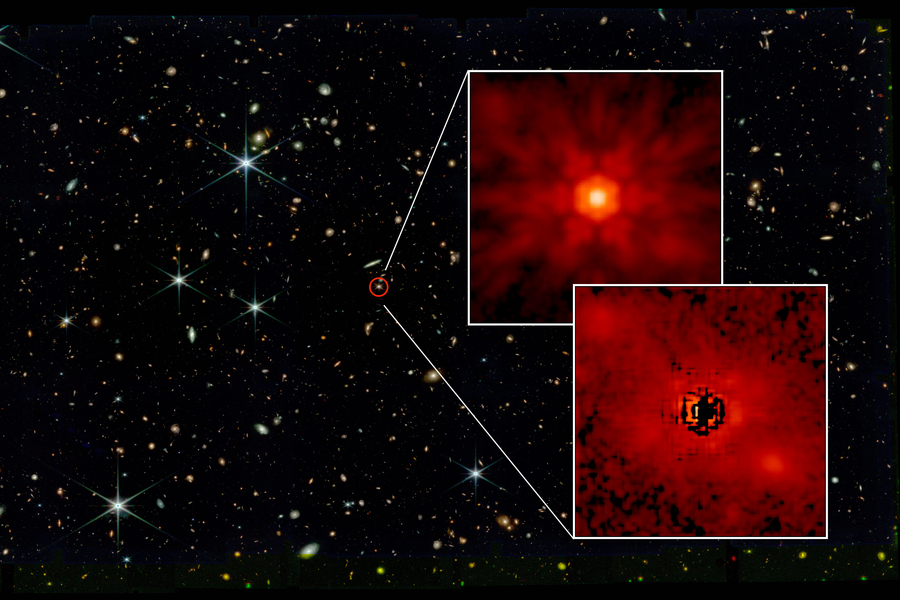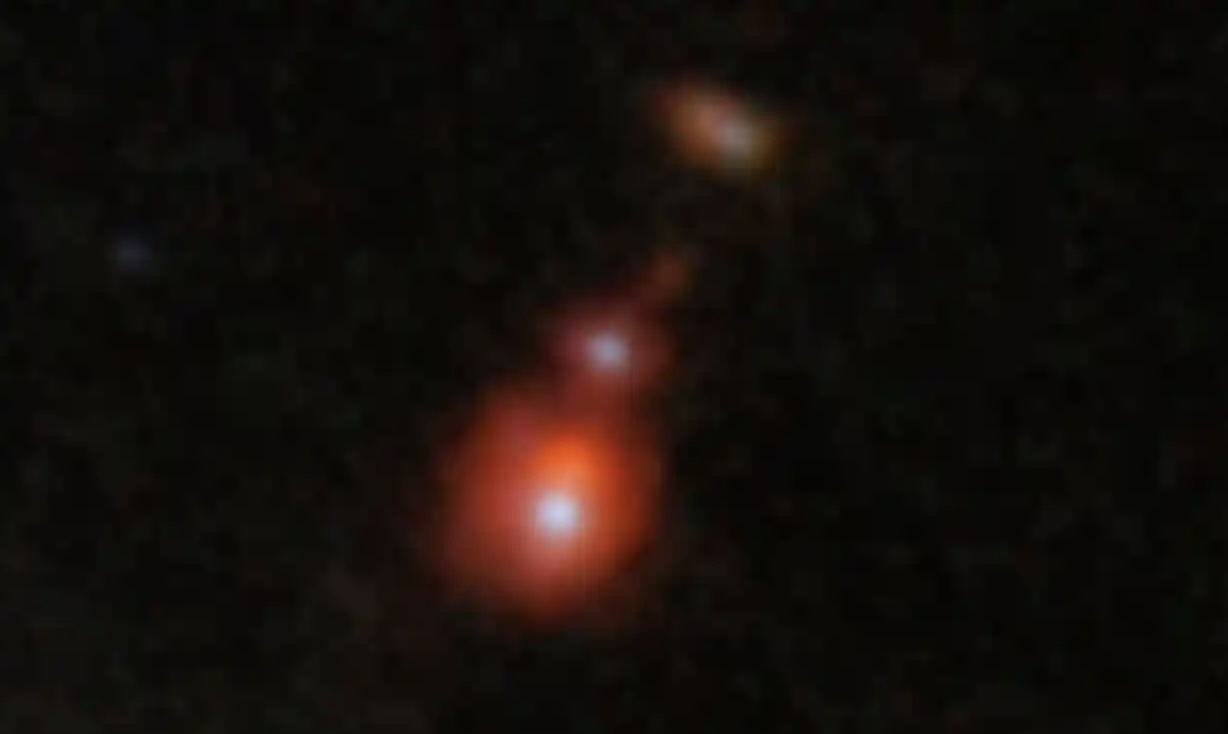7.05.2024
MIT astronomers observe elusive stellar light surrounding ancient quasars

MIT astronomers have observed the elusive starlight surrounding some of the earliest quasars in the universe. The distant signals, which trace back more than 13 billion years to the universe’s infancy, are revealing clues to how the very first black holes and galaxies evolved.
Quasars are the blazing centers of active galaxies, which host an insatiable supermassive black hole at their core. Most galaxies host a central black hole that may occasionally feast on gas and stellar debris, generating a brief burst of light in the form of a glowing ring as material swirls in toward the black hole.
Quasars, by contrast, can consume enormous amounts of matter over much longer stretches of time, generating an extremely bright and long-lasting ring — so bright, in fact, that quasars are among the most luminous objects in the universe.
Because they are so bright, quasars outshine the rest of the galaxy in which they reside. But the MIT team was able for the first time to observe the much fainter light from stars in the host galaxies of three ancient quasars.
Based on this elusive stellar light, the researchers estimated the mass of each host galaxy, compared to the mass of its central supermassive black hole. They found that for these quasars, the central black holes were much more massive relative to their host galaxies, compared to their modern counterparts.
The findings, published today in the Astrophysical Journal, may shed light on how the earliest supermassive black holes became so massive despite having a relatively short amount of cosmic time in which to grow. In particular, those earliest monster black holes may have sprouted from more massive “seeds” than more modern black holes did.
“After the universe came into existence, there were seed black holes that then consumed material and grew in a very short time,” says study author Minghao Yue, a postdoc in MIT’s Kavli Institute for Astrophysics and Space Research. “One of the big questions is to understand how those monster black holes could grow so big, so fast.”
“These black holes are billions of times more massive than the sun, at a time when the universe is still in its infancy,” says study author Anna-Christina Eilers, assistant professor of physics at MIT. “Our results imply that in the early universe, supermassive black holes might have gained their mass before their host galaxies did, and the initial black hole seeds could have been more massive than today.”
Eilers’ and Yue’s co-authors include MIT Kavli Director Robert Simcoe, MIT Hubble Fellow and postdoc Rohan Naidu, and collaborators in Switzerland, Austria, Japan, and at North Carolina State University.
Dazzling cores
A quasar’s extreme luminosity has been obvious since astronomers first discovered the objects in the 1960s. They assumed then that the quasar’s light stemmed from a single, star-like “point source.” Scientists designated the objects “quasars,” as a portmanteau of a “quasi-stellar” object. Since those first observations, scientists have realized that quasars are in fact not stellar in origin but emanate from the accretion of intensely powerful and persistent supermassive black holes sitting at the center of galaxies that also host stars, which are much fainter in comparison to their dazzling cores.
It’s been extremely challenging to separate the light from a quasar’s central black hole from the light of the host galaxy’s stars. The task is a bit like discerning a field of fireflies around a central, massive searchlight. But in recent years, astronomers have had a much better chance of doing so with the launch of NASA’s James Webb Space Telescope (JWST), which has been able to peer farther back in time, and with much higher sensitivity and resolution, than any existing observatory.
In their new study, Yue and Eilers used dedicated time on JWST to observe six known, ancient quasars, intermittently from the fall of 2022 through the following spring. In total, the team collected more than 120 hours of observations of the six distant objects.
“The quasar outshines its host galaxy by orders of magnitude. And previous images were not sharp enough to distinguish what the host galaxy with all its stars looks like,” Yue says. “Now for the first time, we are able to reveal the light from these stars by very carefully modeling JWST’s much sharper images of those quasars.”
A light balance
The team took stock of the imaging data collected by JWST of each of the six distant quasars, which they estimated to be about 13 billion years old. That data included measurements of each quasar’s light in different wavelengths. The researchers fed that data into a model of how much of that light likely comes from a compact “point source,” such as a central black hole’s accretion disk, versus a more diffuse source, such as light from the host galaxy’s surrounding, scattered stars.
Through this modeling, the team teased apart each quasar’s light into two components: light from the central black hole’s luminous disk and light from the host galaxy’s more diffuse stars. The amount of light from both sources is a reflection of their total mass. The researchers estimate that for these quasars, the ratio between the mass of the central black hole and the mass of the host galaxy was about 1:10. This, they realized, was in stark contrast to today’s mass balance of 1:1,000, in which more recently formed black holes are much less massive compared to their host galaxies.
“This tells us something about what grows first: Is it the black hole that grows first, and then the galaxy catches up? Or is the galaxy and its stars that first grow, and they dominate and regulate the black hole’s growth?” Eilers explains. “We see that black holes in the early universe seem to be growing faster than their host galaxies. That is tentative evidence that the initial black hole seeds could have been more massive back then.”
“There must have been some mechanism to make a black hole gain their mass earlier than their host galaxy in those first billion years,” Yue adds. “It’s kind of the first evidence we see for this, which is exciting.”
Quelle: MIT Massachusetts Institute of Technology
----
Update: 18.05-2024
.
Black holes observed colliding when universe was only 740m years old
Glimpse of galactic merger, via James Webb telescope, may explain presence of monster black holes

An image from Nasa showing the ZS7 galaxy system, where cosmologists detected a collision of black holes, one of which was estimated to be 50m times the mass of the sun.
A pair of black holes has been observed colliding in the ancient universe for the first time. The observations, by the James Webb Space Telescope, reveal a merger of two galaxies and the monster black holes at their centres when the universe was just 740m years old, about a 20th of its current age.
The discovery that massive mergers appear to have been common in the infant universe could help explain how supermassive black holes like the one at the heart of the Milky Way achieved such tremendous proportions.
Prof Roberto Maiolino, an astrophysicist at the University of Cambridge, and a member of team behind the observations, said: “One problem that we have in cosmology is explaining how these black holes manage to grow so big. In the past we have always talked about gobbling matter very quickly or being born big. Another possibility is that they grow very fast by merging.”
Until now it was not clear whether the merging of galaxies – which is known to have happened – would also result in the black holes at the centres morphing into a single cosmic sinkhole. Recent models have suggested that one of them would be kicked out into space to become a “wandering black hole”.
The latest observations use the Webb telescope’s ability to get to the far reaches of the cosmos and so have provided the first glimpse of galactic mergers in the distant past.
In the process of merging, black holes gobble up huge quantities of matter and also release a lot of energy, and this activity has distinctive spectral features that allow astronomers to identify them. This activity revealed the collision under way in a system called ZS7, with one of the two black holes estimated to have 50m times the mass of the sun.
“The mass of the other black hole is likely similar, although it is much harder to measure because this second black hole is buried in dense gas,” said Maiolino.
Subsequent observations showed that, of black holes detected at this time period, around a third appeared to be in the process of merging. “This could be a real channel for the rapid growth of early black holes,” he said.
Prof Andrew Pontzen, a cosmologist at University College London, who was not involved in the research, said: “One of the major blanks in our cosmic history book is where giant black holes, millions or billions of times the mass of sun, came from. Do they somehow get born big, or do they have to be built from initially smaller black holes that smash together to form the giants? This new evidence from [the Webb telescope] is indirect, but it helps suggest a major role for black hole collisions.”
Scientists hope in future to be able to make direct measurements of ancient collisions using the next generation of gravitational wave detectors, including the Laser Interferometer Space Antenna (Lisa) mission, which was recently approved by the European Space Agency.
The findings are published in the Monthly Notices of the Royal Astronomical Society.
Quelle: The Guardian

